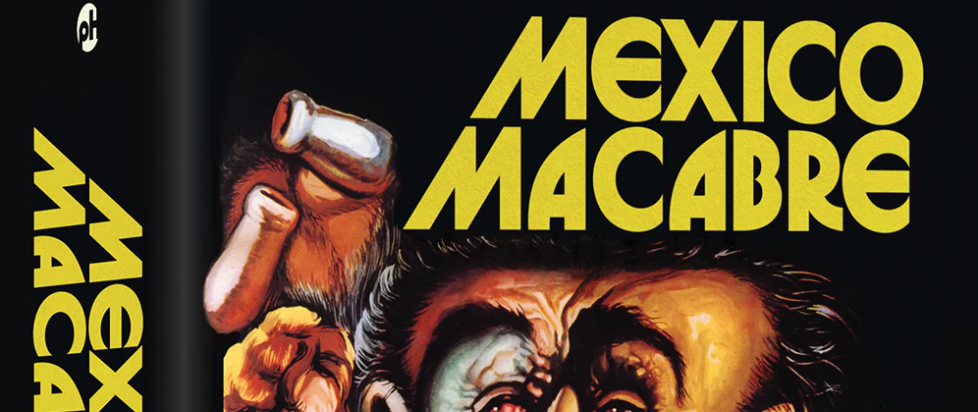
Entering the Kingdom of the Supernatural: The Mexico Macabre Collection from Indicator
I can no longer recall the precise chain of events that led me to fall in love with the Mexican horror films of the ‘50s and ‘60s. All I know is that, for most of the time since it happened, my only access to them has primarily been through poor-quality YouTube rips and out-of-print CasaNegra DVDs acquired via interlibrary loan.
For years, I have longed for someone to come along and start putting some of these incredible films onto Blu-ray, and finally Indicator has answered my prayers with the four titles in the Mexico Macabre collection – what I hope is the first of many such releases. Of these four films, two I had seen before, and two were new to me, which made for a pretty ideal blend.
In the past, I’ve attempted to describe the appeal of Mexican horror films from this era by suggesting that they feel like someone attempting to remake the classic horror films of the ‘30s and ‘40s from memory. Which, given that we were still decades ahead of the advent of home video, was probably almost literally the case. There’s a wonderful “everything and the kitchen sink” approach to many of these films, which borrow from their predecessors with acquisitive glee, repurposing familiar elements into something unique to this subgenre, at this moment.
I don’t have enough space here to write a lengthy ode to these sorts of films more broadly, except to say that they’re well worth your time, especially for those whose knowledge of Mexican horror cinema goes no deeper than the various pictures in which Santo and other masked wrestlers went up against monsters and vampires. Now if I could just get them to do another set with World of the Vampires in it…
“It was like closing my eyes in one room and opening them in another.” – Black Pit of Dr. M (1959)
One of the two films in this set that I hadn’t seen before, this movie was the one I knew the least about going in. The American title doesn’t help. The original Spanish-language title more closely translates to something like “Mysteries from Beyond the Grave,” which is… yes, exactly what this movie is about. In a story that would have felt right at home in an old horror comic book, two doctors working at an asylum make a pact. Whichever one dies first will find a way to bring the other across to the “other side” and then return to live once more in the flesh.
This happens within the film’s first few minutes, and the rest of its running time is the gradual, inexorable working out of the plot to bring the remaining doctor across the veil and return. Naturally, and as he is warned during an early candle-lit séance, this is a “be careful what you wish for” story, and there is a terrible price to pay for crossing over and coming back.
The story from there involves a young girl whom the megalomaniacal Doctor Mazali (Rafael Bertrand) falls in love with though she doesn’t reciprocate his feelings, an assistant who is gruesomely disfigured in an accident and sports an absolutely top-notch burned face effect for the rest of the picture, a murder (of course), an apparent premature burial, and lots and lots of seeming coincidences that we know are actually engineered by the spirit of the deceased doctor as part of the deal to bring Mazali across to the other side and back again.
The Black Pit of Dr. M is directed by Fernando Mendez, who made one of the best-known Mexican gothics of this era, 1957’s El Vampiro, so it should come as no surprise that this is an atmospheric gem, filled with torchlit funeral processions, mist-shrouded courtyards, cheat lights, and much more. For those who are coming to Mexican horror via the more bombastic El Santo flicks – or who were suckered by the lurid American title – this might take a little time to get going, but it pays off in rich EC Comics-style dividends by the end, and may actually be the best film in this set.
“Never have human eyes witnessed anything like it.” – The Witch’s Mirror (1962)

I don’t remember precisely when I first watched The Witch’s Mirror, but I remember why. Silvia Moreno-Garcia had turned me on to it, and it was an instrumental step in my love affair with Mexican gothic horror from this era.
The Witch’s Mirror is sort of like if every gothic horror movie that existed before 1962 all got thrown into a cauldron together. There are elements here of everything from generic mad scientists and premature burials to Rebecca to Eyes without a Face to The Hands of Orlac to the story of Bluebeard and lots more besides – all sort of bookended by a witchy motif that is unique to the film. Also unique is the fact that, despite the lengthy opening monologue about how evil witches are, the witch here is actually the good guy, going to great lengths to right the terrible wrong that kicks off all the horror.
The film also throws a dizzying array of different types of imagery and special effects at the screen. There are plenty of fades and substitutions, as faces are replaced with skulls, the lids of coffins vanish to show us what lies within, and so on. But there is also burned flesh makeup, a couple of low-budget yet genuinely chilling demon scenes, the usual phantom hand stuff, a horrifically doll-like bandaged burn victim, a surprisingly grisly hand amputation, and many more.
Indeed, for a slow and somewhat talky picture, so much happens in The Witch’s Mirror that it could easily have been an anthology film, with a clear break when the mad doctor’s second wife becomes horribly burned in the first place. Perhaps none of it is done with quite the same aptitude as its best incarnations, but it is done with so much zest for the material that it’s hard to fault it, and even harder not to have a great time with this genuine classic of the era and form.
“It could move the most insensitive man.” – The Brainiac (1962)
Like The Giant Claw, a 1957 film directed by Fred F. Sears with which this film has pretty much nothing else in common, The Brainiac enjoys a somewhat worse reputation than I think it deserves, due almost entirely to its idiotic monster. And like in The Giant Claw, the idiotic monster here actually does the movie more good than harm.
The American title of The Brainiac doesn’t help its reputation. Its original title, El Baron del Terror sounds more like what it is and less like a parody of a 1950s sci-fi film. But even without that, the monster, with its pulsating rubber head, its flailing, tubular pincers, its sharp dress sense, and its tendency to suck out human brains would all guarantee that this film isn’t as respectable as The Witch’s Mirror, in spite of coming to us from the same director, Chano Urueta.
Partly, this is due to the fact that The Brainiac is straddling two very different genres. There are certainly elements here of the sci-fi drive in movies that were popular in the States, but there are also plenty of old-fashioned gothic touches. The eponymous baron may look like a sci-fi monster, and the heroes may spend plenty of time peering through telescopes at drawings of the night sky, but the movie’s plot is distinctly supernatural.
The film opens with Baron Vitelius d’Estera being condemned to be burned alive by the inquisition in 1661 for a litany of crimes – many of which he seems to have greatly enjoyed, based on the look on his face as they are read off. In usual villain fashion, he swears that he will return in 300 years, hitching a ride on a passing comet as the auto-da-fe consumes him. Naturally, the action then picks up in 1961, when the comet comes back along, bringing the baron with it.
Many things are left unexplained in all of this. Why does the baron come back looking like a dime store Halloween mask of Gene Simmons? Why does he need to eat brains to live? Though he sucks the brains out with his forked tongue, why does he then store them – still brain-shaped – at room temperature in a big chalice in an unlocked box just inside the door of his house? None of these questions get answered, but that’s fine. There’s a ridiculous monster wearing a nice suit and sucking out brains. What more do you really need?
“Nothing in the world could make me go into that cursed house.” – The Curse of the Crying Woman (1963)

My one sentence Letterboxd review of Curse of the Crying Woman simply reads: “Premium haunted house bullshit.” And if you’re anything like me, that’s all you need to know. Produced by and featuring Abel Salazar, who played the evil baron in The Brainiac, Curse of the Crying Woman is ostensibly another in a long line of Mexican horror films dealing with the legend of la Llorona, although in this one the name is mostly set dressing.
Directed by Rafael Baledon, who also helmed a number of other monster movies including The Man and the Monster and The She-Wolf, this flick feels of a piece with The Witch’s Mirror for its willingness to throw almost everything at the wall. The cold opening obviously owes a debt to Bava’s Black Sunday, while the rest of the film uses copious zooms and close-ups as well as just about every type of special effect you can think of – always deployed in very exciting ways, even while they also often show their seams. There’s one particular moment when you can really see how the famous “walking through cobwebs” sequence from Dracula is pulled off, as the edge of the glass plate onto which the cobwebs are projected is clearly visible.
Also noteworthy in Curse of the Crying Woman is how much the usual gender roles are flipped. Sure, gothic stories frequently have heroines, but in this case, it is our lead’s husband (Salazar himself) who becomes the damsel in distress, while the crazed wife locked up in the attic is also a crazed husband this time around. Even the villain’s naked ambition and bid for power above all else feels somewhat transgressive – at least for the 1960s – when that villain is a woman.
Depending on who you ask, Curse of the Crying Woman was either released in 1961 or 1963. I went with the ’63 date here, partly because it is positioned last in the Mexico Macabre set from Indicator, and was the last of the three films I watched. The date of its release is interesting in part because of a particular sequence in which Salazar’s character is shown a parade of horrors, all rendered in film negative, which include sequences from other Mexican horror films, including 1961’s World of the Vampires and 1959’s The Man and the Monster, to name a few.
———
Orrin Grey is a writer, editor, game designer, and amateur film scholar who loves to write about monsters, movies, and monster movies. He’s the author of several spooky books, including How to See Ghosts & Other Figments. You can find him online at orringrey.com.



